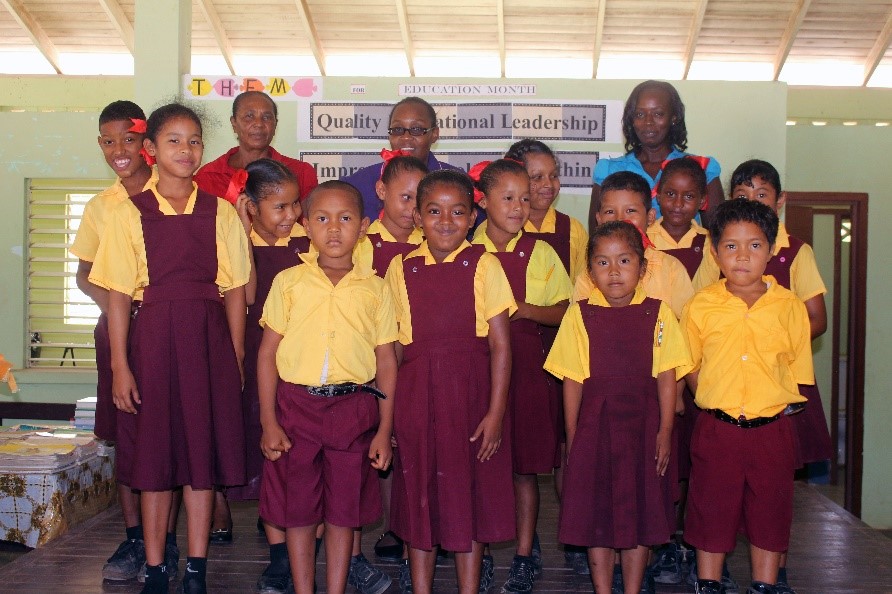Georgetown, May 18, 2016: Propelled by the vision of ensuring that reliable energy is provided to all in Guyana within an economically, environmentally and socially sustainable framework; with increasing consideration of renewable energy sources, in 2014-2015 the Guyana Energy Agency (GEA) conducted a series of Energy Efficient rehabilitative works in communities and at schools in Guyana.
Recently, a visit was paid to ‘47 Miles Village’, one of the communities that benefitted from one such intervention. Located along the Linden-Lethem Highway, between the Demerara and Essequibo Rivers, Forty-Seven (47) Miles village is approximately 47 Miles south of Linden. Governed by a Central Development Committee (CDC), the village has a population of one hundred and fifty-three (153) persons occupying fifty-eight (58) homes.
GEA’s contact with the village was initiated by a request from the chairman, Mr. Godfrey Bowen, to assist the village with solar systems for lighting purposes, so that school children can study in the evenings. Two of GEA’s Engineers subsequently visited the village to conduct an assessment to determine the priority energy needs.
According to Mr. Leon DeSouza, the engineer who spearheaded the project, it was discovered that sources of lighting within the village consisted of battery powered LED lamps, kerosene lamps and 12 volts DC lamps powered by lead acid automotive batteries. He explained that since LED lamps are powered from non-rechargeable D size dry cell batteries, their useful life is short as they utilize over 4 batteries in a period of 3 – 4 days. Further, the automotive batteries used for domestic purposes had to be constantly charged using a tractor. The tractors are used for logging activities and would not operate every day, therefore, residents are required to wait for it to be in operation or provide the fuel for charging their batteries.
The team visited various locations and buildings within the community; these included a school that housed nursery and primary levels, the teacher’s living quarters, a health facility and a number of households. As a matter of priority it was decided to facilitate Energy Efficient rehabilitative works at the school, teachers living quarters and the health facility.
“The school at the time had no energy source” said Desouza, “while the teachers’ living quarters had a 260-watt solar photovoltaic system, which was used primarily for lighting and operating small equipment. The system only functioned for short periods during sunny days”, he further explained.
Upon investigation, it was found that the system had no batteries and the energy that was used was not stored but came directly from the solar panels. Hence, the power supply only lasted for a few hours. Thus, lights were not available at nights which made the teachers’ work difficult and compromised their safety.
The community’s health facility, which provided basic healthcare services such as vaccination while emergency cases were transferred to Linden or Georgetown, used battery powered lamps to provide lighting when needed. The lack of lighting resulted in the invasion of bats which resulted in items being destroyed and a significant amount of bat droppings which was a health hazard. “…While the facility had a 165-watt solar photovoltaic array and a 10 ampere charge controller that required a battery to be operable,” DeSouza explained, “it was used to operate a radio set for communication which was defunct owing to the introduction of cellular service facilitated by a cellular tower installation at ‘Fifty-Eight Miles’ village”.
In the recent follow up visit, Head Teacher of the school, Ms. Michelle Downer, said that the installation at the school has allowed for enhanced education.
“There was never any electricity before because the installation was not properly done…since it was rectified, along with other technical assistance from GEA, we are now able to involve the children in the Ministry of Education ‘Interactive Radio Instruction’ (IRI) programme which has helped to enhance their numeracy and development of other listening skills,” she elaborated.
As it relates to the Teachers’ Quarters, Miss Downer indicated that they are now able to light both the interior and exterior of the building which has given them an additional sense of security…“Prior to the intervention there were robbery attempts and break and entering. Since the installation there has been no such attempts. Teachers are also now able to work later”.
At the health Centre, which is located just a stone’s throw away from the Teachers’ living quarters, the report was very similar. Nurse Natoya Ashby indicated that there was no electricity available to facilitate lighting the building nor compound. She indicated that since the installation the health centre now has a refrigerator which aides in assisting with the vaccination process.
“We usually get the vaccines from the Linden hospital Complex and it is stored in a vaccine carrier that is lined with cold packs. However, there are some parents who cannot make it early, the refrigerator is very useful as it allows for the storage of additional cold packs which are used to replace those in the carrier; thereby allowing the vaccines to be kept at the right temperature to facilitate those parents who cannot make it early,” Nurse Ashby explained. Additionally, she indicated that that there were break and entry incidents prior…“however since we were able to light the building and compound no such incident has occurred”

The Guyana Energy Agency will continue to facilitate such interventions as part of its community outreach with the aim of realizing its vision to provide reliable energy that is economically, environmentally and socially sustainable for all in Guyana.

